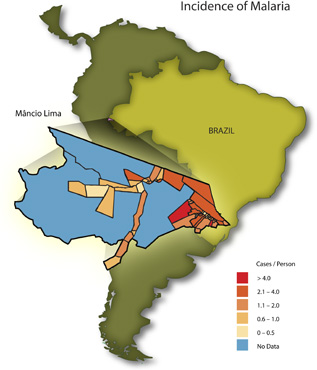Incidence of malaria jumps when Amazon forests are cut
Establishing a firm link between environmental change and human disease has always been an iffy proposition.
Now, however, a team of scientists from the UW–Madison, writing in the current (June 16, 2010) online issue of the CDC journal Emerging Infectious Diseases, presents the most enumerated case to date linking increased incidence of malaria to land-use practices in the Amazon.
The new UW study shows that a 4 percent increase in deforestation can spark a 48 percent jump in the incidence of malaria by creating favored habitat for the mosquito that is the primary carrier of the disease in the region.
Map: Barry Carlsen
The report, which combines detailed information on the incidence of malaria in 54 Brazilian health districts and high-resolution satellite imagery of the extent of logging in the Amazon forest, shows that clearing tropical forest landscapes boosts the incidence of malaria by nearly 50 percent.
“It appears that deforestation is one of the initial ecological factors that can trigger a malaria epidemic,” says Sarah Olson, the lead author of the new report and a postdoctoral fellow at the Nelson Institute, Center for Sustainability and the Global Environment.
The clearing of tropical forests, say Olson and senior author Jonathan Patz of the University of Wisconsin School of Medicine and Public Health, creates conditions that favor malaria’s primary carrier in the Amazon, the mosquito Anopheles darlingi, which transmits the malaria parasite if it draws its blood meals from infected humans.
“The deforested landscape, with more open spaces and partially sunlit pools of water, appears to provide ideal habitat for this mosquito,” Olson says, noting that Anopheles darlingi has been shown to displace other types of mosquitoes that prefer forest and that are far less prone to transmit malaria.
“This study of human malaria cases complements our previous work that focused more on the abundance of the malaria-carrying mosquito,” Patz adds. “In those studies from the Peruvian Amazon, we showed a correlation between this mosquito’s larvae and aquatic breeding sites in disturbed habitats following land clearance.”
The new Wisconsin study focused on 54 Brazilian health districts in a corner of the Brazilian Amazon near Peru and where detailed health and population data were collected in 2006 by Brazilian researchers. Combined with high-resolution satellite data of changes in land cover, the health data reveals the large human-health impact of relatively small changes to the forest landscape.
“A 4 percent change in forest cover was associated with a 48 percent increase in malaria incidence in these 54 health districts,” notes Olson. “The health data used in the study is of the highest quality and spatial resolution. Unlike previous studies, our data allowed us to zoom in on areas where people are being exposed to malaria and to exclude areas where they are not being exposed.”

Health clinics such as this one pictured in 2006 in Brazil’s Amazon basin not only provide medical care to Brazil’s rural population, but also can be key nodes for gathering data on the incidence of malaria.
Photo: courtesy Eduardo Marques Macário
The health districts reflected in the Wisconsin study are typical of many of the thousands of such districts spread across Brazil and its Amazon region. Since 2001, the Brazilian Ministry of Health has similarly monitored and treated malaria in more than 7,000 districts. Deforestation in the districts, says Olson, is occurring as it typically does in Amazonia, and occurs mostly near rivers, the backbone of the region’s transportation system, and spreads outward.
The new work, argues Patz, an authority on environmental change and human health, shows how deforestation and land clearing contribute to malaria’s dynamic at the frontier of settlement. “In 2006, the county that encompasses these health districts was in the top five of all Brazilian counties with malaria,” Patz says. “Even after we adjusted for human populations, access to health care and other factors, malaria hot spots paralleled locations with the most destruction of rainforests.”
The message from the study, say Olson and Patz, is that tropical forest conservation may benefit human health more than we realized.
“Land-management practices show promise as useful interventions to reduce malaria risk factors,” says Olson.
Patz and Olson believe the new work provides a template that could be used to spatially track environmental risk factors and the incidence of malaria, which infected an estimated 500,000 Brazilians annually across the Amazon basin from 1997 to 2006. “The technology is there. The health data is there. Health officers with cell phones could gather data for the whole Amazon region,” Olson says.
The National Aeronautics and Space Administration funded the new study.
Tags: biosciences, health & medicine





